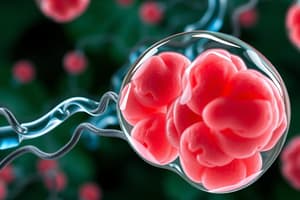Podcast
Questions and Answers
The ways Carbon Dioxide is carried in the blood include ___% dissolved in the plasma.
The ways Carbon Dioxide is carried in the blood include ___% dissolved in the plasma.
7-8%
What is carbaminohaemoglobin?
What is carbaminohaemoglobin?
A compound formed by carbon dioxide combining with the globin part of the haemoglobin molecule.
How does carbon dioxide travel to the plasma?
How does carbon dioxide travel to the plasma?
Carbon dioxide diffuses into the plasma due to a difference in carbon dioxide concentration.
What happens to the carbon dioxide now that it is in the plasma?
What happens to the carbon dioxide now that it is in the plasma?
What does the carbonic acid do?
What does the carbonic acid do?
What happens to the carbon dioxide that is dissolved in the blood when it reaches the capillaries surrounding the alveoli?
What happens to the carbon dioxide that is dissolved in the blood when it reaches the capillaries surrounding the alveoli?
What does the carbaminohaemoglobin do once the blood reaches the capillaries surrounding the alveoli?
What does the carbaminohaemoglobin do once the blood reaches the capillaries surrounding the alveoli?
What do the hydrogen ions and bicarbonate ions do?
What do the hydrogen ions and bicarbonate ions do?
Flashcards are hidden until you start studying
Study Notes
Transport of Carbon Dioxide in Blood
- Carbon dioxide is transported in three main forms:
- 7-8% is dissolved directly in plasma.
- 22% combines with globin in hemoglobin, forming carbaminohemoglobin.
- 70% is converted to bicarbonate ions in plasma.
Carbaminohemoglobin
- A compound created when carbon dioxide binds to the globin portion of hemoglobin, facilitating transport.
Mechanism of Carbon Dioxide Movement
- Carbon dioxide diffuses into the plasma from body cells during blood flow through capillaries, driven by concentration gradients.
Fate of Carbon Dioxide in Plasma
- Within the plasma, carbon dioxide can:
- Dissolve directly.
- Bind to hemoglobin.
- React with water to form carbonic acid (H2CO3).
Action of Carbonic Acid
- Carbonic acid dissociates into hydrogen ions (H+) and bicarbonate ions (HCO3-), playing a role in acid-base balance and transport.
Carbon Dioxide Release in Alveoli
- When blood reaches capillaries surrounding the alveoli, dissolved carbon dioxide diffuses out of the blood into alveolar air.
Breakdown of Carbaminohemoglobin
- In the alveoli, carbaminohemoglobin dissociates, releasing carbon dioxide that subsequently diffuses into the alveolar space.
Conversions of Hydrogen Ions and Bicarbonate Ions
- Hydrogen and bicarbonate ions recombine to form carbonic acid which, under enzymatic action, dissociates into water (H2O) and carbon dioxide, with the latter diffusing into the alveoli for exhalation.
Studying That Suits You
Use AI to generate personalized quizzes and flashcards to suit your learning preferences.




